The Method of Sufi Preaching in the Qadiriyya Tariqa for Religious Guidance in the Community of Majene Regency
Abstract
The purpose of this study is to understand the method of Sufi preaching of the Qadiriyah tariqa in religious development in the community of Majene Regency. This research uses a descriptive qualitative research design located in Majene Regency. The research approach used includes the science of preaching, guidance, and communication approach. The primary data source of this research is Ilham Shaleh, the Qadiriyah tariqa murshid, as the Key Informant, additional informants include Muhammad, the chairman of the Kh Muahammad Shaleh Islamic boarding school foundation, the chairman of the Majene District MUI, and the Majene community itself. Secondary data sources include tariqa books and other data sources. Data collection methods include observation, in-depth interviews, and documentation. Data analysis is carried out through three stages: data reduction, data presentation, and conclusion drawing.
The results of this study indicate that the Sufi preaching method carried out by the Qadiriyah tariqa in Majene Regency is divided into several parts, namely: the practice of dhikr (remembrance of God), recitation of litanies, and the study of Sufi books such as the Jawahirul bihar fifadailil muhtar al-fuyudatul rabbaniyah authored by Sheikh al-Qadri al-Insan al-Kamil, and the Hikam authored by Sheikh Ibnu Hikam as-Sakandar.
The implications of this research are expected to be beneficial to the wider community, particularly to the people of Majene, so that they can emulate and delve deeper into the teachings of the Qadiriyah tariqa as one of the means to become more obedient to the commandments and teachings of Islam. It is also hoped that the Qadiriyah tariqa associations can provide in-depth responses to opinions that may undermine the Qadiriyah tariqa. Furthermore, they are expected to accurately record the number of Qadiriyah tariqa followers as a form of support for the success of the tariqa itself.
Downloads
References
Bahri, Khatib Syamsul, Tasawuf Abdul Rauf Sinkel dalam Tanbih Al-Masyi, Padang: Hayfa Press, 2012.
Hilman, M., resonansi spiritual wali qutub Syehk abdul Qadir jilani, jakarta: kalam mulia, 2004.
Ishaq, Mahfus, Sejarah Pemikiran Dan Pengaruh Tarekat Qadiriah, Dakwah Jakarta: Kencana Prenada Media Group, 2006.
Mardalis, Metode Peneletian Suatu Pendekatan Proposal, Jakarta: Bumi Aksara, 1995.
Moleong, Lexy J., Metodologi Penelitian Kualitatif, Bandung: Remaja Rosdakarya, 2002.
Nasution, Harun, Falsafat dan Mistisisme dalam Islam. (Cet. XII; Jakarta: Bulan Bintang, 2008
Sayuti, M. Ali, Metodologi Penelitian Agama Pendidikan Teori dan Praktek, Cet I; Jakarta: Raja Grafindo Persada, 2010.
Shadily, Hasan, Sosiologi untuk Masyarakat Indonesia, Cet. IX; Jakarta: Bina Aksara, 1983.
Suyanto, Bagong, & Sutiah, Metode Penelitian Sosial Berbagai Alternatif Pedekatan, Cet: VI Jakarta: Kencana 2011.
Sugiyono, Metode Penelitian Pendidikan, Pendekatan Kuantitatif, Bandung: Alfabeta, 2007.
Shaleh, Ilham, Manakib Syekh Kh Muh. Shaleh, Makassar: 2012.
Valiuddin, Mir, Zikir dan Kontemplasi Dalam Tasawuf, Bandung: Pustaka Hidayah, 1996.


